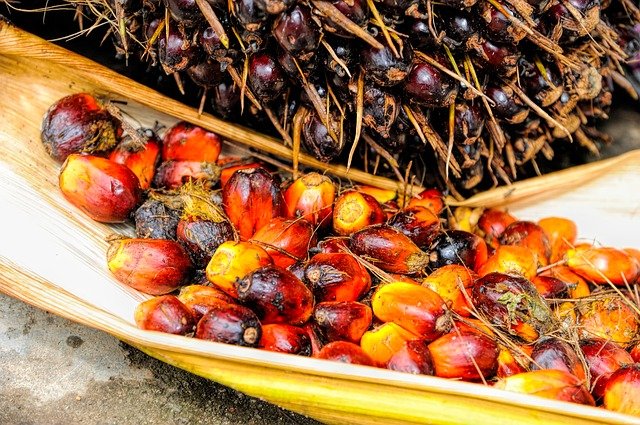
Palm oil is often said to be bad for you. Let’s see what palm oil is and if it is true that it can cause damage to health.
Those who habitually read or study the labels of food products before buying them at the supermarket, will certainly have noticed several times the words “palm oil” (often hidden behind the more generic words “vegetable oil” or “vegetable fats”) in the list of ingredients. But what is palm oil? And why is it so widely used in the food industry?
Palm oil: what it is and what characteristics it possesses
Palm oil is a non-hydrogenated vegetable oil that is obtained from the shrub of the same name, Elaeis guineensis, a plant native to Africa and now widely cultivated in Malaysia and Indonesia. Simply saying palm oil, in reality, means expressing a rather vague concept, given that there are three different types of oils that differ according to the origin and the processing to which they are subjected, such as: crude palm oil, palm kernel oil, refined palm oil.
The crude palm oil is obtained from the palm fruits of which it maintains the characteristic orange-red color, due to the high concentration of carotenoids, precursors of vitamin A. At room temperature it has a semi-solid consistency similar to lard, due to the high quantity of saturated fatty acids (normally present in meat and animal fats) which, however, are compensated by the presence of a good dose of antioxidants and vitamin E.
Fatty acids make up about 50% of the total fats present, and the most representative is palmitic acid, a long-chain saturated acid; the remaining percentage is made up of monounsaturated (40%) and polyunsaturated (10%) fatty acids.
Palm kernel oil, on the other hand, is obtained from the seeds of the plant. It also has a semi-solid consistency at room temperature, because it is rich in saturated fatty acids, but has a white color reminiscent of butter because it is devoid of carotenoids.
Refined palm oil (or bifractionated palm oil) is the result of “bifractioning” and refining, mechanisms that allow it to be converted into liquid form. During these processes, however, it loses all the antioxidants present in the raw form, and therefore all the beneficial part in favor (alas) of saturated fatty acids alone.
Nutritional values per 100g of refined palm oil:
- Waterfall: 0 g
- kcal: 884
- Proteins: 0 g
- Fat: 100 g
- of which saturated: 49.3 g
- Carbohydrates: 0 g
- of which sugars: 0 g
- Vitamin E: 15.94 mg
- Glycemic index: 0
- Cholesterol: 0 g
- Linoleic acid: 9.2 g
- Linolenic acid: 0.2 g
Palm oil in the food industry
Refined palm oil is widely used in the food industries for frying food and for the preparation of packaged products such as biscuits, snacks, ice cream, chocolate and spreadable chocolate, ready-made soups, etc., to which it can give creaminess and crunchiness, acting from thickener. But why do you prefer to use palm oil? Here are some reasons.
- Palm oil is less delicate than other oils which, deteriorating quickly, would form toxic substances that would be potentially harmful. Palm oil, on the other hand, has a strong resistance to temperature and sun, making it the best oil for the correct conservation of packaged foods.
- Reaching the smoke point very slowly, it is ideal for cooking food.
- It is colorless, tasteless, highly versatile and workable but, above all, it is very economical.
- It is easily digestible due to the presence, among others, of medium-chain fatty acids that more easily pass through the intestinal wall.
Is palm oil bad for your health?
The real nutritional value and actual negative impacts palm oil can have on health are still a source of controversial studies. There are those who absolutely affirm that palm oil is bad and demonizes it without the possibility of appeal given the high presence of saturated fatty acids, which raise blood cholesterol and thus favor the onset of cardiovascular disorders.
On the contrary, there are also those who place the emphasis, positively enhancing it, on the high content of vitamin E and carotenoids. In reality, the controversy stems from confusion and unclearness as to which of the three types of oil we are talking about.
For all its characteristics, crude palm oil does not in itself represent a major risk for heart and arterial health or for the problem of overweight and obesity. Unfortunately, however, what is used by the food industries is not this, but its refined equivalent which, as already mentioned, has now lost all its beneficial substances.
Fats should not be completely eliminated from the diet: in a correct diet they should make about 30% of the total kcal, of which 7-10% represented by the saturated ones. However, an excess of saturated fat in the diet can increase the risk of cardiovascular disease, and the main point is that we often consume more than necessary and even unconsciously, precisely because palm oil is contained in so many products of daily use.
A recent study has shown that palm oil refining produces some carcinogenic and potentially toxic substances for the body. Following studies like this, several companies in the food sector have decided to withdraw products containing refined palm oil from the market as they are considered dangerous for health. However, it should be noted that the studies have been conducted on rather large quantities of palm oil, which are difficult to achieve with a healthy and balanced diet.
The damage to the environment caused by palm oil
Why is palm oil also associated with environmental damage? Everything is connected to the growing demand for this product in the most varied sectors.
If before it was seen as a low-cost oil, not suitable for the food sector, today it also finds space on our tables and inside the bauty-farms for the same reason. Companies save and therefore it is favored over other much more valuable and expensive oils.
Multinationals are increasingly demanding palm oil and palm oil monocultures in Africa and Southeast Asia have replaced traditional crops. There has been massive deforestation due to this business, but not only that.
The elimination of traditional cultivation, which involved a mix of vegetation profitable for the environment, has brought enormous changes also in terms of climate. The soil has been stripped of all its properties, unable now to hold back the rains. Their disposal is further compromised due to the dense presence of palm trees, arranged not in a natural way but in concentrated rows with the aim of maximizing the production of the precious oil.
A study has shown that due to the large amount of palm oil, Indonesian forests will disappear by 2020. Palm cultivation is concentrated in Indonesia and Malaysia and is bringing the forests of the island of Sumatra and animals who live them in their last days. Forests destroyed, loss of rare plant and animal species.
People hunt animals away to recover parts of land to be exploited for the purpose of cultivating palm trees. The animals are thus killed or forced to live in very small areas. Experts have conducted studies showing how palm oil production in Indonesia and Malaysia has reduced to 30 species, the more than 80 categories of mammals present before.
All biodiversity is under threat. Insects and rodents find themselves without the main nutrients, as a result small mammals have no more prey to hunt and birds migrate to better places. A bleak picture of course, but not sufficient to clarify how far the damage is going.
What can we do then?
We try to make smarter purchases, sifting through the labels of what we are about to buy, reducing as much as possible or eliminating the use of those containing palm oil and therefore replacing snacks and snacks with seasonal fruit and vegetables: 1 biscuit is made up of at least 10 different ingredients, more or less healthy, more or less fat; 1 apple is always 100% made only from apple. Furthermore, we always prefer extra virgin olive oil, a local product very rich in benefits.
How to recognize palm oil on the label
When you go to the supermarket, to make sure you are not buying products containing palm oil, it is good to learn to read food labels carefully. Fortunately, since the end of 2014, European legislation has imposed transparency on food labels. The legislation provides for the replacement of the more generic and misleading wording “vegetable oils” or “vegetable fats” with a clearer and more exhaustive wording. We can therefore find on the labels the items “palm vegetable oil” (or “palm vegetable oil, rapeseed, etc. ..) or simply “palm oil“, Which clearly inform the consumer about the presence of this element.






